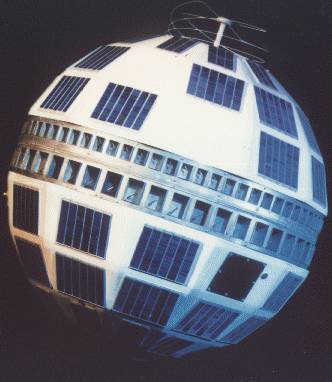Scale-Model Exhibit of Telstar Satellite
at Pittsburgh's Buhl Planetarium

Photograph of the original Telstar satellite. A scale-model exhibit of the Telstar satellite was displayed at Pittsburgh's original Buhl Planetarium and Institute of Popular Science from the 1960s through 1991.
Satellite Model: Telstar 1 - A model of the Telstar 1 satellite, the first commercial communications satellite launched by AT&T on 1962 July 10, was first displayed in an AT&T (Bell Telephone Company of Pennsylvania) display case exhibit (titled "Telstar Satellite"), as part of the "Science Serves Industry" exhibit series, in the eastern section of the Great Hall on the first floor of Pittsburgh's original Buhl Planetarium and Institute of Popular Science, in the 1960s through the early 1980s. In the late 1980s and early 1990s, this satellite model was displayed on a table (which included a Guest Register) at the entrance to the third floor Observing Room of Buhl Planetarium's (then known as Buhl Science Center) original
Astronomical Observatory. The primary instrument of this Astronomical Observatory was the rather rare
10-inch Siderostat-type Refractor Telescope, then the second largest siderostat-type telescope in existence, and the only one to have regular public observing sessions.
More on the Telstar satelite.
Walsh, Glenn A.
"Space Artifacts Move to New Climate-Controlled Facility." Blog Post.
SpaceWatchtower 2014 Feb. 20.
Walsh, Glenn A.
"Telstar Satellite Accidentally "Nuked" 50 Years Ago." Blog Posting.
SpaceWatchtower 2012 July 12.
Pittsburgh's original
Buhl Planetarium and Institute of Popular Science displayed a
model of Telstar 1, first in an AT&T exhibit, and then in Buhl's Siderostat Observatory.
Return to
Astronomical Observatory of The Buhl Planetarium and Institute of Popular Science, Pittsburgh
Return to
History of The Buhl Planetarium and Institute of Popular Science, Pittsburgh
